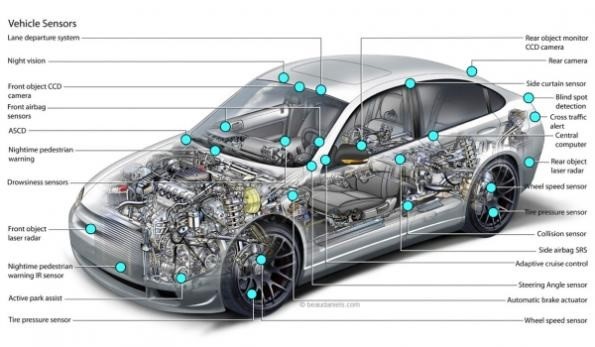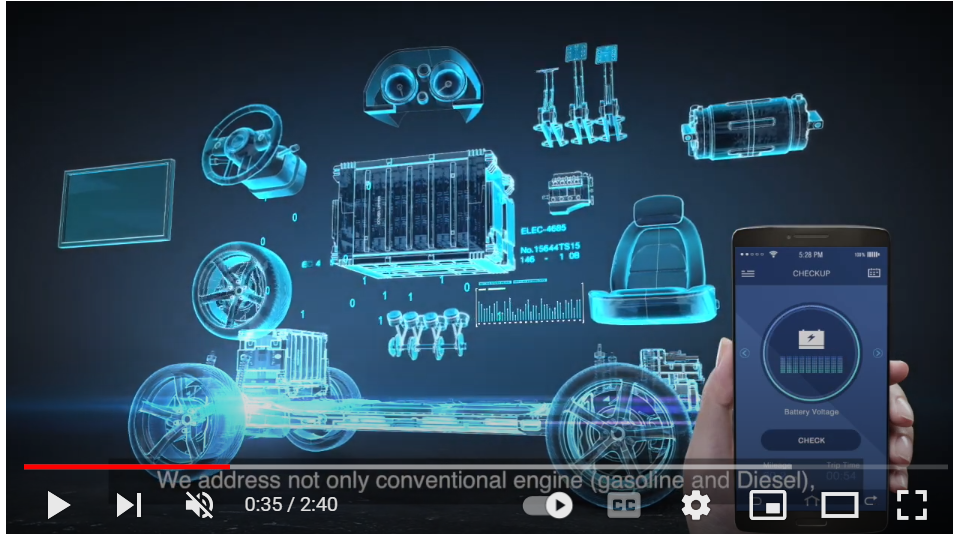Lesson 8 Virtual sensors in the automotive industry
Today, vehicles are full of electronics and thus with sensors that provide information well beyond speed and fuel levels. They deliver a limitless amount of information about the vehicle’s condition, whether this applies to parking assist, tire pressure, engine performance, fuel consumption, vehicle dynamics, thermal management, and many more.
Car sensors are divided into several categories, depending on the role they play in the operation of the vehicle. There are several types of sensors used in automation – which can be considered essential, as well as monitoring sensors, without which the car can function, but which improve the driving experience [[i]].
Oxygen sensors: These sensors help control pollutant emissions and fuel consumption by measuring the level of oxygen in the exhaust gases. In modern vehicles, one such set of sensors is mounted on the exhaust manifold, and another set after the catalytic converter. Depending on the oxygen level detected, the on-board computer will increase or decrease the amount of fuel pumped into the injection system.
Benefits:
- ensures optimal fuel consumption;
- prevent the failure of the catalyst and other engine components;
- reduce polluting gas emissions by up to 90%.
Fuel temperature sensor
The fuel pumped into the injection system must be at a certain temperature, and this sensor tells the on-board computer if the optimum value has been reached. Too low a temperature causes slow burning due to increased fuel density, while too high a temperature causes rapid burning. The sensor constantly monitors the fuel so that it is pumped at the optimal temperature.
Benefits:
- prevents increased fuel consumption;
- avoids the failure of some engine components;
- allows a constant supply of fuel.

9‑3. Figure_ Sensor locations of a vehicle of today (Image courtesy of Car from Japan)
Currently, each vehicle has approximately 60 to 100 sensors on board and this number is expected to rise. As cars get smarter, analysts are predicting that the number of sensors is projected to reach more than 200 sensors per car by 2020. (Source: Automotive Sensors and Electronics 2017). 200 sensors per car represent 22 billion sensors used in the automotive industry per year. No wonder that physical sensing technology is about to reach its limits.
Hardware sensors are often deemed expensive, and have a reduced life expectancy when exposed in a hazardous environment (for example in an engine).
In addition, physical sensors are costly to design and install due to the extreme conditions they must withstand, such as borderline temperatures or hard-to-reach locations. Consequently, sensors may fail to guarantee reliable output. Virtual sensors offer a valuable alternative in this respect.
At the powertrain controls department of Renault-Nissan, in order to comply to Euro 6 and Euro 7 standards, the car manufacturer has made technical decisions with regards to the engine architectures and its controls strategies. Together with the Simcenter Engineering and Consulting services team, Renault-Nissan performed a synthesis of virtual sensors and controllers at the same time, to get ready for next generation powertrains (hybrid, electric and internal combustion engines).
The Simcenter Engineering experts used artificial intelligence methods, and more specifically neural networks, to automatically select the most informative signals and combining them in a virtual sensor.
9‑4. Figure_ Workflow for virtual sensor & controller synthesis
[https://blogs.sw.siemens.com/simcenter/the-sense-of-virtual-sensors/]

9‑5. Figure_ Renault | Coupling virtual sensors with artificial intelligence | Simcenter Amesim
[https://blogs.sw.siemens.com/simcenter/the-sense-of-virtual-sensors/]
Using Simcenter Amesim for closed-loop simulation of plant models and controller executable specifications, Renault-Nissan is now able to verify and validate control systems against functional requirements early in the design process.
[i] https://www.fordroadhill.ro/noutati/tipuri-de-senzori-auto
